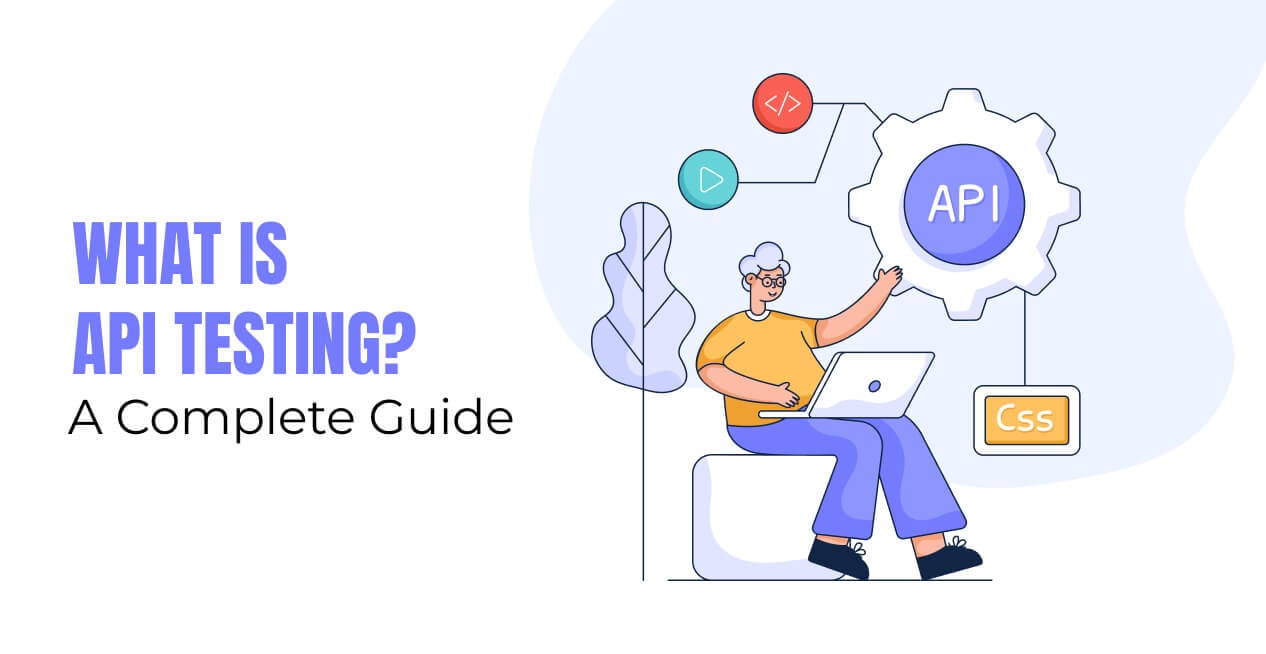Introduction
APIs are the latest tech trend going viral amongst developers. For those who must know, APIs or Application Programming Interface is a medium with which two or more computer programs communicate with each other. In laymans’ terms, APIs are the software that help other pieces of software to interact with each other. A document that further describes how to build and use an API key is called an API specification.
For example, a software developer creating a food delivery app might need GPS service. This is when the app ‘talks’ to Google maps via the Application Programming Interface and retrieves the data it needs to display to its users.
What is API Testing?
API testing is a type of software testing that helps developers focus on an API’s performance and reliability. Software intermediates known as APIs allow for communication between various systems, applications, and services. API testing strategy usually involves two steps which are: Calling API keys and then evaluating its results. There are various API testing types to look out for.
API Testing Types
API Testing helps developers use external functions in their software or access foreign environments and ensure that the APIs are working properly and conveniently. There are many types of API testing conducted during multiple development stages. Given below are some and their corresponding stages they are conducted in.
API Integration Testing
Software testing or “integration testing” is aimed at confirming how various software modules or components interact with one another. The basic goal of integration testing is to find and fix any flaws that can appear when various modules are combined and operate as a single system.
There are different phases of integration testing, including:
- Component integration: This type of testing process includes putting individual modules or components to test to make sure they can interact as intended.
- System integration testing entails examining how various systems or subsystems interact to make sure they function as intended.
- Testing the complete system, including all subsystems and components, is known as end-to-end integration and it is done to make sure the system can work as intended.
Runtime error detection
Run time error detection in API testing usually includes a detailed analysis of an API software that checks the API for null pointers, exceptions, resource leaks, race conditions, memory leaks, etc. Runtime error detection can be applied during unit testing, integration testing,component testing, system testing or penetration testing. This testing also helps identify defects that can be found only during runtime. It also betters the application by avoiding probable causes of application crashing, or slowly loading.
Security testing
As API grants accessibility to all external services, to work and collaborate with one’s own software. This makes the software developed, more vulnerable to attacks. Security Testing ensures that the software developed is protected against such attacks and bugs. Penetration testing and Fuzz/noise testing are types of security testing. Penetration Testing attempts breaching the code in multiple ways so that ways can be designed to counter such attacks in the future. Fuzz/Noise testing, on the other hand, attempts to overwhelm the software with pseudo noise to check the software’s performance under heavy load.
Performance testing – Load testing and Function Testing
Performance testing involves two types of testing – Function Testing and Load Testing. Function testing involves a thorough analysis of the software’s unique features. It assesses the responses of the tests run, and determines based on the output’s correctness, whether it falls within predetermined parameters. Functional testing of APIs also takes into account edge cases for boundary conditions in addition to standard operating situations. Load Testing, on the other hand, takes care of how an API performs under varied load conditions. Both are extremely crucial in checking an API for its performance.
Interoperability testing
Interoperability testing is yet another type of testing that determines if two or more components are capable of sharing information and communicating with one another. It is often carried out when many software systems or components must cooperate in order to realize a single objective. Interoperability testing’s primary objective is to make sure that the systems or components being tested can communicate with one another without experiencing any compatibility problems or failures. The many interfaces, protocols, and data formats that the systems or components utilize to communicate with one another are tested to accomplish this.
Validation Testing
Software validation testing examines a software system or product to see whether it satisfies all criteria and specifications from the client. The fundamental goal of validation testing is to make sure that the software system fulfills all user and business requirements and is appropriate for its intended usage.
Prior to the deployment of the software system and usually following system testing, validation testing is carried out. It comprises a number of actions and tests intended to verify that the software system is prepared for deployment and complies with all client needs and specifications.
Advantages of API Testing
API testing has proven to be extremely beneficial , -here is how:
Early detection of defects
API testing can help detect defects in the earliest stages of the software development lifecycle. This makes it easy for developers to identify potential failures in the software early on, take care of them rather than waiting for the last stage of development.
Increased software quality
Needless to say, rigorous API testing guarantees quality in the product. By ensuring that APIs are operating as intended and providing the necessary functionality, API testing delivers a sound user friendly product.
Faster time to market
API testing helps reduce the time it takes to introduce the software to the market by simultaneously taking care of potential bugs and errors.
Better collaboration
API testing can help improve collaboration between development and testing teams, enabling them to work together to identify and resolve issues.
Reduced maintenance costs
API testing can help reduce maintenance costs by detecting defects early and preventing failures at later stages.
API Testing Tools
Here are some of the tools that are quite popular amongst developers.
Postman
One of the most popular and preferred API testing tools in the market is Postman. Postman allows users to develop and share HTTP requests, analyze outputs while automating test cycles. Another added feature of the tool is known to support both manual and automated testing, and also provides collaboration features for teams.
SoapUI
SoapUI is a powerful API testing tool that supports testing of both SOAP and REST APIs. It offers a user-friendly interface, supports data-driven testing, and also provides integration with other testing tools.
JMeter
Yet another extremely popular open-source tool is JMeter. JMeter is a versatile tool used by developers for a variety of load testing and performance testing of APIs. It is capable of hosting a wide range of protocols, including HTTP, FTP, and JDBC. This makes it easy to integrate with other testing tools and software.
REST-assured
As a Java-based API testing tool, REST-assured offers a user-friendly API for testing RESTful APIs. Along with automated testing, Rest-assured lets users create tests in JavaScript, and can be easily configured in other testing environments.
Assertible
Assertible is a popular cloud-based API testing platform that enables customers to quickly create and run automated API tests. It actively interacts with CI/CD technologies and delivers stringent and precise reports .
Karate
Karate is yet another open-source API testing tool preferred by developers and businesses. The best part of using Karate testing is that it supports both REST and SOAP APIs. This particular API testing tool provides an intuitive syntax for creating tests while supporting data-driven testing, and easy integration with other testing tools.
API Testing Challenges
Even though there are many benefits of API testing, they come with their limitations. Few of them are:
Understanding the API
Precise API testing demands a refined understanding of the functionality and data formats the API uses. It might be challenging to create efficient test cases without a thorough study of the particular APIs.
Handling complicated APIs
APIs with several endpoints are often challenging to test. Testing several endpoints requires distinct settings and data sets. This can be a real challenge for developers looking to test their APIs.
Managing dependencies
Testing APIs in isolation is tricky since API’s are dependent on other systems and environments. It’s critical to recognise these dependencies and adjust accordingly to testing environments.
Security testing
APIs are susceptible to security threats such as denial-of-service attacks, injection assaults, and session hijacking. It is crucial to recognise possible loopholes in an API’s security and address them at the earliest.
Best Practises of API Testing
API Testing is a precise process which requires extensive knowledge and experience. Here are a few tips to facilitate API testing and get best results while developing a project.
Understand the basics of API testing
API Testing is a rigorous process. It is important for developers to have an optimum understanding of the basics of API testing. One must also read the documentation and other available materials.
Use the right testing tools
After understanding a project’s requirements, it is just as important to know which tool is best suited for your project. Tools like Asserible, Karate, REST-assured, Jmeter etc offer a lot of features and metrics, and can be used to refine testing of a project.
Cover all aspects of Testing
Testing involves checking a variety of elements in an API including input validation, error handling, security etc. Updating testing documentation simultaneously, along with API changes, is a good practice as it helps keep a track of testing progress.
Apart from these, one must also ensure that API testing is part of continuous integration and process pipeline. API tests should also be easy to write, should be small and concise and should be executed with speed.
Conclusion
In this era of saturated markets and cutthroat competition, businesses must stand out with quality products and exceptional services. API Testing takes care of the former. With stringent testing, the quality of the product gets refined at every stage. There are many software development companies delivering stellar API testing services these days. One of them is OpenXcell, a software development company that has delivered solutions which employ creative and innovative APIs and are stringently tested to give their clients nothing but the best quality of product.









